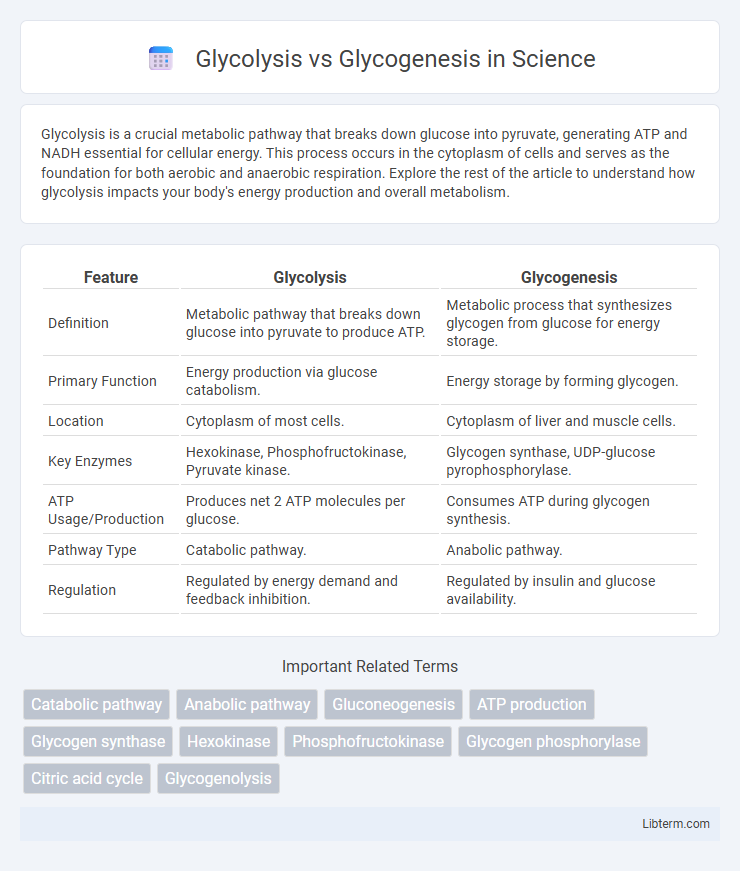Glycolysis is a crucial metabolic pathway that breaks down glucose into pyruvate, generating ATP and NADH essential for cellular energy. This process occurs in the cytoplasm of cells and serves as the foundation for both aerobic and anaerobic respiration. Explore the rest of the article to understand how glycolysis impacts your body's energy production and overall metabolism.
Table of Comparison
| Feature | Glycolysis | Glycogenesis |
|---|---|---|
| Definition | Metabolic pathway that breaks down glucose into pyruvate to produce ATP. | Metabolic process that synthesizes glycogen from glucose for energy storage. |
| Primary Function | Energy production via glucose catabolism. | Energy storage by forming glycogen. |
| Location | Cytoplasm of most cells. | Cytoplasm of liver and muscle cells. |
| Key Enzymes | Hexokinase, Phosphofructokinase, Pyruvate kinase. | Glycogen synthase, UDP-glucose pyrophosphorylase. |
| ATP Usage/Production | Produces net 2 ATP molecules per glucose. | Consumes ATP during glycogen synthesis. |
| Pathway Type | Catabolic pathway. | Anabolic pathway. |
| Regulation | Regulated by energy demand and feedback inhibition. | Regulated by insulin and glucose availability. |
Introduction to Glycolysis and Glycogenesis
Glycolysis is a metabolic pathway that breaks down glucose into pyruvate, producing ATP and NADH, serving as a primary energy source for cells. Glycogenesis is the anabolic process of synthesizing glycogen from glucose molecules, enabling energy storage primarily in liver and muscle tissues. Both pathways play crucial roles in maintaining glucose homeostasis by balancing energy production and storage.
Overview of Carbohydrate Metabolism
Glycolysis and glycogenesis are central pathways in carbohydrate metabolism, regulating glucose utilization and storage. Glycolysis breaks down glucose into pyruvate, generating ATP and NADH for cellular energy, while glycogenesis converts excess glucose into glycogen for energy storage in liver and muscle tissues. These pathways coordinate to maintain blood glucose levels and ensure energy availability during varying metabolic demands.
Glycolysis: Definition and Key Steps
Glycolysis is a metabolic pathway that converts glucose into pyruvate, producing ATP and NADH as energy sources for cellular functions. Key steps include glucose phosphorylation by hexokinase, fructose-6-phosphate conversion by phosphofructokinase, and the cleavage of fructose-1,6-bisphosphate into glyceraldehyde-3-phosphate and dihydroxyacetone phosphate. This anaerobic process takes place in the cytoplasm and is essential for energy production in both aerobic and anaerobic conditions.
Glycogenesis: Definition and Process
Glycogenesis is the biochemical process of synthesizing glycogen from glucose molecules, primarily occurring in liver and muscle cells for energy storage. This anabolic pathway begins with glucose phosphorylation to glucose-6-phosphate, which is then converted to glucose-1-phosphate and activated to UDP-glucose before glycogen synthase catalyzes the formation of a-1,4-glycosidic bonds in glycogen. Glycogenesis plays a crucial role in maintaining blood glucose levels and providing a rapid energy source during periods of high demand or fasting.
Enzymes Involved in Glycolysis vs Glycogenesis
Glycolysis primarily involves key enzymes such as hexokinase, phosphofructokinase-1, and pyruvate kinase, which catalyze the conversion of glucose to pyruvate while generating ATP. In contrast, glycogenesis relies on enzymes like glycogen synthase and branching enzyme to facilitate the synthesis and branching of glycogen from glucose molecules. The regulation of these enzymes determines whether glucose is metabolized for energy via glycolysis or stored as glycogen through glycogenesis.
Key Differences Between Glycolysis and Glycogenesis
Glycolysis is the metabolic pathway that breaks down glucose into pyruvate, generating ATP and NADH, primarily occurring in the cytoplasm of cells. Glycogenesis, in contrast, is the anabolic process that synthesizes glycogen from glucose molecules for energy storage, mainly in liver and muscle cells. Key differences include glycolysis being a catabolic pathway releasing energy, whereas glycogenesis is a biosynthetic, energy-consuming pathway focused on glycogen formation.
Regulation Mechanisms of Glycolysis and Glycogenesis
Regulation of glycolysis primarily involves key enzymes like hexokinase, phosphofructokinase-1 (PFK-1), and pyruvate kinase, which respond to cellular energy levels through allosteric effectors such as ATP, AMP, and citrate. Glycogenesis is predominantly controlled by glycogen synthase, whose activity is modulated via reversible phosphorylation in response to hormonal signals like insulin and glucagon. These regulatory mechanisms ensure metabolic balance by promoting glycolysis during high energy demand and glycogenesis during excess glucose availability.
Physiological Roles and Significance
Glycolysis serves as a critical metabolic pathway that converts glucose into pyruvate, providing immediate energy through ATP production essential for cellular activities. Glycogenesis functions in energy storage by synthesizing glycogen from glucose, primarily in liver and muscle cells, ensuring glucose availability during fasting or increased energy demand. Together, these processes regulate blood glucose levels and maintain energy homeostasis vital for physiological stability.
Clinical Implications and Disorders
Glycolysis, the metabolic pathway that breaks down glucose to produce energy, is critically impaired in conditions like diabetes mellitus, leading to disrupted glucose homeostasis and elevated blood sugar levels. Glycogenesis, the process of glycogen synthesis for energy storage, is affected in disorders such as glycogen storage diseases (e.g., Von Gierke disease), causing abnormal glycogen accumulation and subsequent liver and muscle dysfunction. Understanding the balance between glycolysis and glycogenesis is essential for managing metabolic disorders and developing targeted therapies for insulin resistance and hypoglycemia.
Conclusion: Comparative Insights
Glycolysis and glycogenesis serve distinct yet complementary roles in cellular metabolism, with glycolysis breaking down glucose into pyruvate to generate ATP and glycogenesis synthesizing glycogen for energy storage. The balance between these pathways is crucial for maintaining glucose homeostasis, responding dynamically to energy demands and insulin signaling in tissues like muscle and liver. Understanding their regulation provides insight into metabolic diseases such as diabetes, where impaired glycolysis or glycogen synthesis disrupts normal glucose utilization and storage.
Glycolysis Infographic

 libterm.com
libterm.com